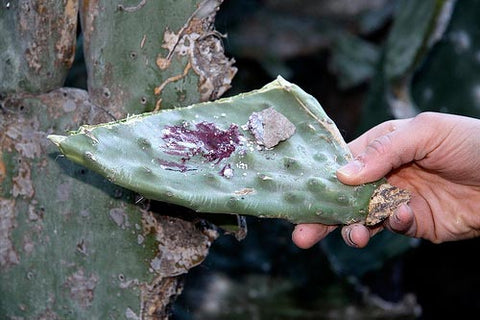Cochineal, or carmine as it is commonly known, is a red insect dye that has been used for centuries to dye textiles, drugs, and cosmetics. In cosmetics, cochineal is used to dye lipstick, blush, and eyeshadow.
The color created from this cochineal dye is absolutely beautiful. It creates bright, bold and deep red colors. But perhaps the most stunning part of this incredible dye is where it originates. Cochineal red dye is actually the result of harvesting insects.

Cochineal is sourced from the female cochineal parasitic insect native to Mexico, Central and South America. Its origin as a red dye made from insects has spanned centuries. In fact, before the Spanish arrived in Mexico in the 1500s, the cochineal insect had already been in wide use as a dye by the native people of Oaxaca for centuries. It was the Spanish, however, that opened up the rest of the world to this incredible red insect dye, and it still remains as a choice red dye to this day.
How This Red Insect Dye Works:
Here’s how it works: The cochineal insect is a type of parasitic bug that latches onto prickly pear cacti (its host) in order to extract the sap. It’s then harvested from these cacti and dried out in the sun. The cochineal itself is about the size of a lentil bean, but when hundreds of them are ground down to a powder, and then subsequently mixed with water, they release a beautiful and intense scarlet red dye.
Not only is cochineal often used in the cosmetic and textile industries, but it’s also a common dye used in the food industry as well. It might be bad for business to write “bug juice” in the ingredient list, so companies tend to do their best to mask this ingredient with different names. Just check your ingredient list for these words: Carminic acid, carmine, red insect dye, or cochineal extract. As crazy as it sounds, cochineal is quite a common ingredient in many of today’s processed foods, and is most commonly found in soft drinks, candies, jello, yogurt and maraschino cherries.
Cochineal in Recent Times
In more recent times, cochineal dye has become increasingly popular as consumers began demanding more “natural” colors and flavorings as opposed to the petroleum and coal-tar based dyes that are largely used in today’s cosmetics industry. Quite distinct from such dyes, carmine is natural and non-toxic, and doesn’t contain the dangerous heavy metal residues from artificial colors like Red 40 and Red 2.
Many people still herald cochineal as a natural and renewable resource, and one that is certainly safer than the artificial stuff. But we at Axiology still choose to keep our lipstick free of both this red insect dye and all artificial colors and dyes. We are proud to proclaim that our lipsticks and cosmetics will always be vegan. We realize that the cultivation and harvesting of insects for dye products is probably the last thing concerning today’s average consumer, but it’s our approach at Axiology to be free of any use of animal products for aesthetic benefit, regardless of how small these critters might be. In fact, we have created a fully vegan true red lipstick fittingly titled, True, which we are very proud of. 
For more information about this red insect dye and to determine your view on carmine check out these articles:
http://gentleworld.org/natural-colors-carmine-cochineal/
http://www.amybutlergreenfield.com/A%20Perfect%20Red_Mexico.html
http://www.npr.org/templates/story/story.php?storyId=1302796
Photo Source:
http://www.smithsonianmag.com/arts-culture/cochineal-coloring-is-that-a-bug-in-your-food-50654458/





